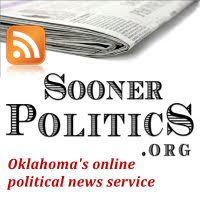Brecheen: Nix Art Spending Mandate
With Oklahoma’s projected 650 million dollar budget shortfall, priorities matter now more than ever and for this reason I have filed SB14 to repeal SB1347.
Enacted in 2004, Senate Bill 1347 (“State of Oklahoma: Art in Public Places Act”), required that 1.5 percent of the cost of construction or renovation of state-owned projects (highway construction or public buildings) be set aside for artwork. It has applied to projects costing at least $250,000 with the maximum assessment not exceeding $500,000. By statute, the artwork has been spent in, on, or near facilities or highways. More than $5 million dollars will soon be spent in current project compliance and millions more in expenditures have already occurred/are on the horizon. Most of these dollars are going for projects in or near Tulsa and Oklahoma City.
Oklahoma is cutting funding to agencies and programs because of the shrinking budget yet we are spending millions of dollars on public art. Some are asking for an explanation. Last summer, a Marshall county community leader took the time to visit with me about this area of state expense. After researching it further, I promised to work on a repeal of the Oklahoma Arts in Public Places Act. I spoke about it for many months and in filing SB14, I am following suit on that commitment.
Those supporting the passage of SB1347 (six years ago) argued public art would enhance the quality of life for Oklahomans and make the state more attractive to out-of-state companies. I absolutely agree. In a time of surplus and with a secured transportation system this might be worthwhile expenditure for bridge art (as found in Dallas, Texas) or artwork for the state capitol itself. However, given our economic situation this is not the time for such expenditures in, on or near random state buildings in Oklahoma City or Tulsa. Local/private finances should be looked for if these projects are deemed local priorities. Oklahoma has the highest number of deficient roads and bridges of any state in America and securing structural integrity must take priority over public art.
Even though this is a small part of the budget, every link in the chain of armor is vital in protecting our state from fiscal harm and our citizens from physical harm (accident resulting from a collapsing bridge or insufficient highway shouldering). Whether supporting federal earmarks or expenditures such as public art, opposing opinion is always the same: “It’s such a small part of the budget, so it’s not a big deal.” This attitude allows that any expenditure under a certain amount is acceptable for politicians to engage in as “nobody will really miss it”. I oppose this D.C like attitude which has led to a 14 trillion dollar national indebtedness with each American’s share now at over $450,000 per man, woman, and newborn child. I’m convinced that all spending that is not absolutely vital, whether it’s small, medium or large should be curtailed until the checkbook is balanced.
As of January 16th, The Tulsa World has published an editorial (“Public Art, Controversial from the Parthenon to the present, by Wayne Greene”), in opposition to the filing of SB14, and for good reason. Those living in Tulsa have every reason to want the state taxpayer investing in their city. They use the example of President Lincoln’s pushed completion of the U. S. Capitol during the Civil War as an example when public art was opposed by public officials, but was nonetheless a good investment. This is a poor comparison. I would not be opposed to completing our national or state capitol if so needed. What I am opposed to is the reality of Oklahoma tax dollars currently being spent on a twisted steel structure that towers into the sky at the cost of hundreds of thousands of dollars. This steel structure is hardly a Parthenon.
Many supporting public art will cite the beautification projects found in Texas. In comparing Oklahoma to Texas, however, one learns that Texas doesn’t have a public arts program. The Texas Department of Transportation, does have the OPTION to spend money on highway art/carvings, but no more than one percent. The respected art on the High Five in Dallas cost $1.3 million, or one half of one percent of the total project budget. Texas can afford to do this because they have taken care of structural integrity first and foremost. According to the annual CNBC America’s Top States for Business, Texas once again ranks first out of 50 states in terms of their overall transportation system. Their fully functional/manicured transportation system provides tremendous incentives for attracting manufacturers. The 2010 CNBC ranking places Oklahoma’s transportation system among the ten most deficient systems in America.
Last year more than 75% of all new jobs in America originated in Texas but art is not responsible for this amazing statistic. We must not perceive it is the tail wagging the dog and confuse what really provokes state growth. As long as out of state motorists entering Oklahoma experience significant differences in road conditions once crossing the state line, we must prioritize asphalt above art. Our ability to attract industry depends on it.
Public art in/near cities and public art on highways/bridges are two completely separate categories but both are receiving funding under current Oklahoma statute. I will concede that public art can further encourage economic development by giving visitors a more positive first impression of a town or city. Public art can enhance the character, splendor and the beauty of a community. And yes, it has the potential to rejuvenate rundown areas. However, to ask state taxpayers at large to pay for Tulsa/Oklahoma City’s urban redesign, I believe, is overreaching. Successful partnerships between municipalities and the private individuals who live in those cities (those who will benefit directly) should be the funding source for artwork not fixed to highways. The state taxpayer at large should not pay for city attractions.
Public art in/near towns and cities can and should continue without the state leading this charge. Edmond has experience and expertise with this by tapping private dollars matched by city funding. The Norman Public Arts Board was the beneficiary of 320 private donations which made possible their recent unveiling of a three story structure known as “Indian Grass”. The rejuvenation of Oklahoma City through Metropolitan Area Projects (MAPS) or Project 180 is the direct result of local leadership. Those inspired and taking pride in those changes have local leaders to thank, not the state legislature.
Once our state experiences economic recovery, excess state finances and we have safe highway conditions, I will support bridge artwork. It can draw attention to our state in a positive way. But we just can't afford it right now and public safety is more important than beautification.
Josh Brecheen, R-Coalgate, is the state senator for Senate District 6, which covers Bryan, Johnston, and Marshall counties, and portions of Atoka and Coal counties.










0 comments:
Post a Comment
PLEASE INCLUDE YOUR NAME when commenting. Anonymous comments may be rejected if NOT accompanied by a name.
Comments are welcome, but remember - commenting on my blog is a privilege. Do not abuse that privilege, or your comment will be deleted.
Thank you for joining in the discussion at MuskogeePolitico.com! Your opinion is appreciated!